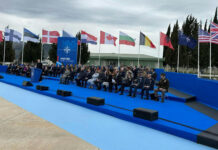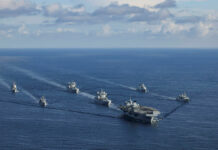The Boeing P-8A Poseidon maritime patrol aircraft is bringing enhanced presence and capability for NATO maritime operations, particularly in anti-submarine warfare and particularly in critical regions like the North Atlantic.
On 1 July 2023, the Norwegian Armed Forces announced on social media that the Royal Norwegian Air Force’s (RNoAF’s) Lockheed Martin P-3 Orion maritime patrol aircraft (MPA) fleet had conducted its last day of operations. Already waiting in the wings – and, in fact, already deploying on operations – was the RNoAF’s new fixed-wing airborne anti-submarine warfare (ASW) fleet, in the form of the Boeing P-8A Poseidon MPA. “Now, our fleet of P-8 Poseidons take over the important mission of monitoring maritime areas in the High North region,” the armed forces’ statement added.
Norway has become the third member of the P-8A Poseidon club to be operating the aircraft in the Euro-Atlantic theatre, after the US and the UK – with Germany next up as the fourth member. Australia, India, and New Zealand are the established P-8A operators in the Indo-Pacific theatre, with South Korea and (possibly) Canada set to follow suit. Canada, with strategic interests across three oceans (the Atlantic, the Arctic, and the Pacific), would of course deploy its MPA capability across both the Indo-Pacific and Euro-Atlantic theatres.

The P-8A Poseidon has arguably now become the pre-eminent fixed-wing airborne ASW platform around the world. It has become so at precisely the time when the operational requirement for ASW capability has returned with some significance amongst Western and partner navies operating across these two theatres.
In the Euro-Atlantic theatre, the RNoAF’s P-8A presence at Evenes airbase, just south of Andoya, illustrates the geostrategic nature of the ASW challenge facing NATO and other navies operating in the region. MPA presence in that region traditionally has been focused on – and still needs to focus on – the Greenland-Iceland-UK (GIUK) Gap. The GIUK Gap has been a choke point that NATO forces have picketed – in the air, on the surface, and below the surface – to monitor, deter, disrupt, and defend against Soviet and then Russian submarine movements south through the Gap and into the North Atlantic.
The enduring nature of the ASW challenge around the GIUK Gap has been underlined by the fact that several countries – the US, UK, and Norway, but also France and Germany – have worked together to provide MPA presence across the region, working out of RNoAF bases, but also UK Royal Air Force (RAF) bases in Scotland, and Iceland’s Reykjavik airbase.
Today, the submarine threat is different. While in the Cold War days, the Soviet Union demonstrated more of a global presence, the Russo-Ukraine war (which broke out in February 2022, with Russia’s invasion of Ukraine) demonstrated that Russia’s geostrategic focus now falls much more on the European side of the Euro-Atlantic theatre.
In this geostrategic context, Russia’s development of improved submarine technology, when harnessed with key capabilities like the Novator 3M14 Kalibr long-range sea-launched cruise missile system, means that Russian nuclear-powered attack (SSNs), nuclear-powered guided-missile (SSGNs), and diesel-electric submarines (SSKs) can all remain further North, in and immediately around Russian waters, while still being able to threaten targets ashore and at sea across Northern Europe.
Consequently, the geostrategic circumference of NATO’s ASW focus has expanded, particularly to the east, to encompass what is now becoming known as the Bear Island Gap. Running south from Svalbard, past Bear Island, to northern Norway, and dividing the relatively shallow waters of the Barents Sea from the deep waters of the Norwegian Sea, the Bear Island Gap has become a new choke point for NATO forces to picket. Monitoring this new choke point and providing airborne ASW across it will be a key task for NATO MPAs.
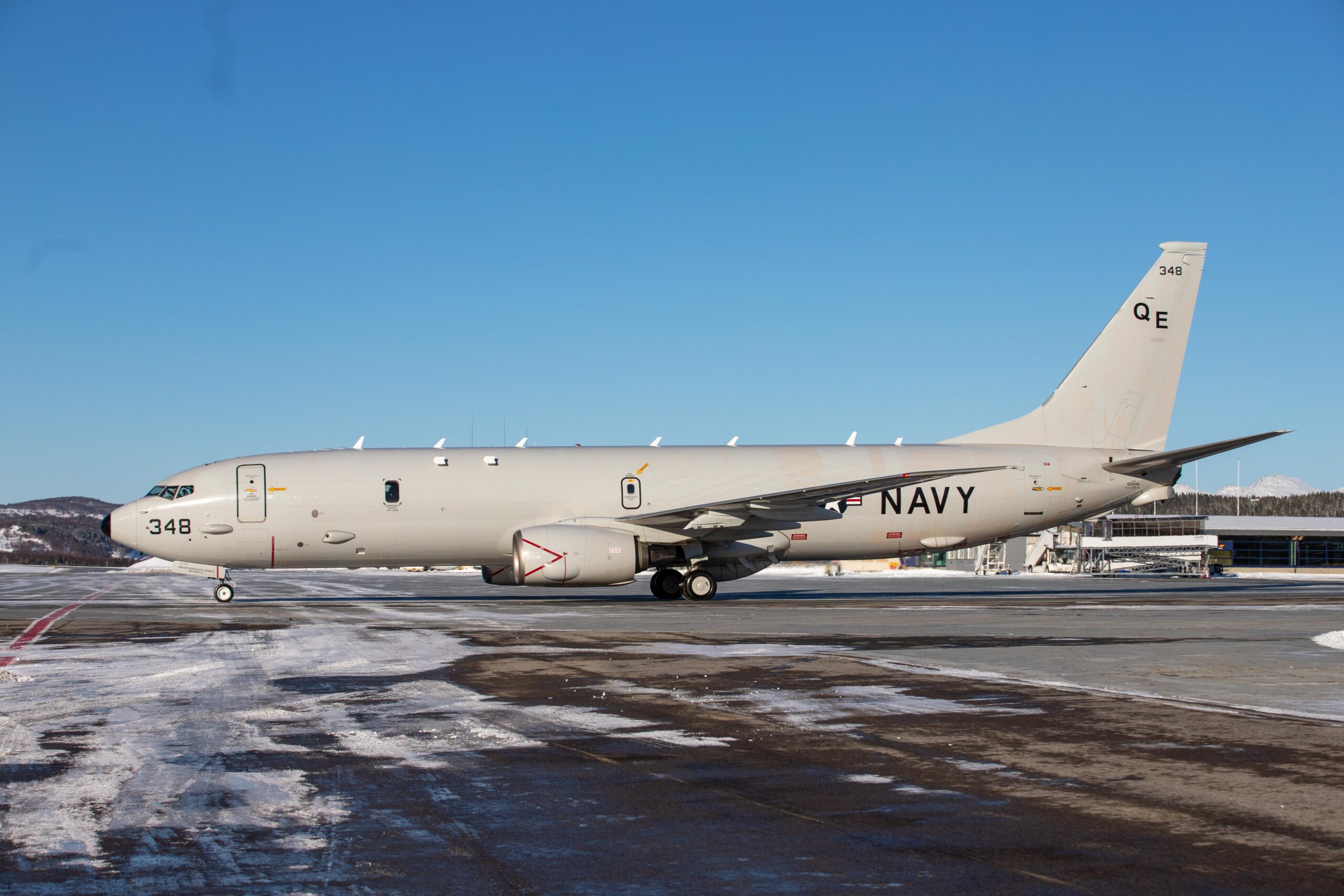
Layered Capability
In terms of delivering ASW capability, MPAs provide just one of several layers – layers covering the air, surface, and sub-surface environments – to provide capability for detecting, localising, classifying, and tracking a submarine target.
The airborne ASW layer deployed across Northern Europe includes rotary-wing aviation assets, such as the Lockheed Martin MH-60R Seahawk, Northern Helicopter Industries’ NH-90, and AW101 Merlin HM2 ASW helicopters. In the ASW role, helicopters are used to deploy sonobuoys and dipping sonars. Destroyers and frigates provide the bulk of the surface coverage, not only embarking these and other ASW helicopters as their organic aviation capability but also carrying hull-mounted and towed array sonars.
Below the surface, submarines and – increasingly – unmanned underwater vehicles (UUVs) including gliders and autonomous underwater vehicles (AUVs) provide sensing capability and, especially, capacity to track and target an adversary’s submarine ‘close in’. The sub-surface ASW layer also includes capabilities such as static seabed-based sonar networks.
Naval operators and analysts may say that the best way to hunt a submarine is with another submarine. Yet each layer contributes in different ways, hence the requirement for layered ASW. Today, such layers work in an ever-more integrated manner, for example through multi-static ASW operations, where multiple assets across the networked layers can process the acoustic ‘pings’ made by other assets, reducing the target submarine’s ability to focus solely on the acoustic ‘source’ of the sonar ‘ping’ as the threat.
In explaining the broad role of an MPA capability in layered ASW operations, Dr Sidharth Kaushal –Research Fellow for Sea Power at the Royal United Services Institute (RUSI) think-tank in London – noted that an MPA provides, in effect, the second layer in this ASW capability. As the first layer of defence, “low-granularity sources of data such as hydrophone arrays or low-frequency active sonar can identify possible contacts,” Kaushal explained. “However, to identify them as a possible target of interest requires an asset [for example, an MPA] with the speed to get to the rough location in a timely way before the contact has moved too far away.”

“MPAs that combine speed, endurance, and a range of acoustic and non-acoustic sensors are useful for this,” Dr Kaushal added. Discussing the role of MPA capabilities in the on-going development of ASW capability, Dr Kaushal said that multi-static sonobuoy fields will be a key part of building MPA contributions to ASW networks. Here, he pointed in particular to the Sparton/Ultra Electronics AN/SSQ-101 and AN/SSQ-125 sonobuoys that the US Navy (USN) already deploys from its P-8As.
A multi-static approach, including through the use of sonobuoys, brings the benefits of mitigating the effects of acoustic reverberations underwater (for example from the source of any acoustic ‘ping’) and extending the sensing range of the assembled assets including sonobuoys, Dr Kaushal explained.
In this operational context, an MPA’s contribution can be assessed in two ways. First, broadly in terms of deployability, an MPA brings speed in reaching a target both close in and at distance: it also brings increased surveillance time-on-target, due to sustained endurance. Second, broadly in terms of ASW operations, it brings the ability to search, identify, and prosecute the submarine, both independently and as part of a joint network (including in a multi-static context). Thus, in the ASW operational context, the P-8A’s contribution is clear, and is supported by core capabilities.
The P-8A is based around the commercially proven Boeing 737-800 airframe. Most of the P-8A operating club members are using a sensor and weapons fit that follows that fitted onboard USN P-8As. This includes, in sensor terms: the Raytheon AN/APY-10 multi-mode synthetic aperture radar; inverse synthetic aperture radar capability; the L-3 Communications WESCAM MX-20HD optoelectronic infra-red (IR) system; the Northrop Grumman AN/ALQ-240 electronic support measures (ESM) capability; and up to 129 sonobuoys of different types (including active, passive, and multi-static active).
In weapons terms, the aircraft’s fit includes: the USN/Raytheon Mk 54 lightweight torpedo; and the Boeing AGM-84D Harpoon anti-ship missile. Communications are provided through the Link 16 and the Common Data Link (CDL) tactical communications networks, which can help underpin the P-8A’s input to any ASW networks as a command-and-control (C2) node.
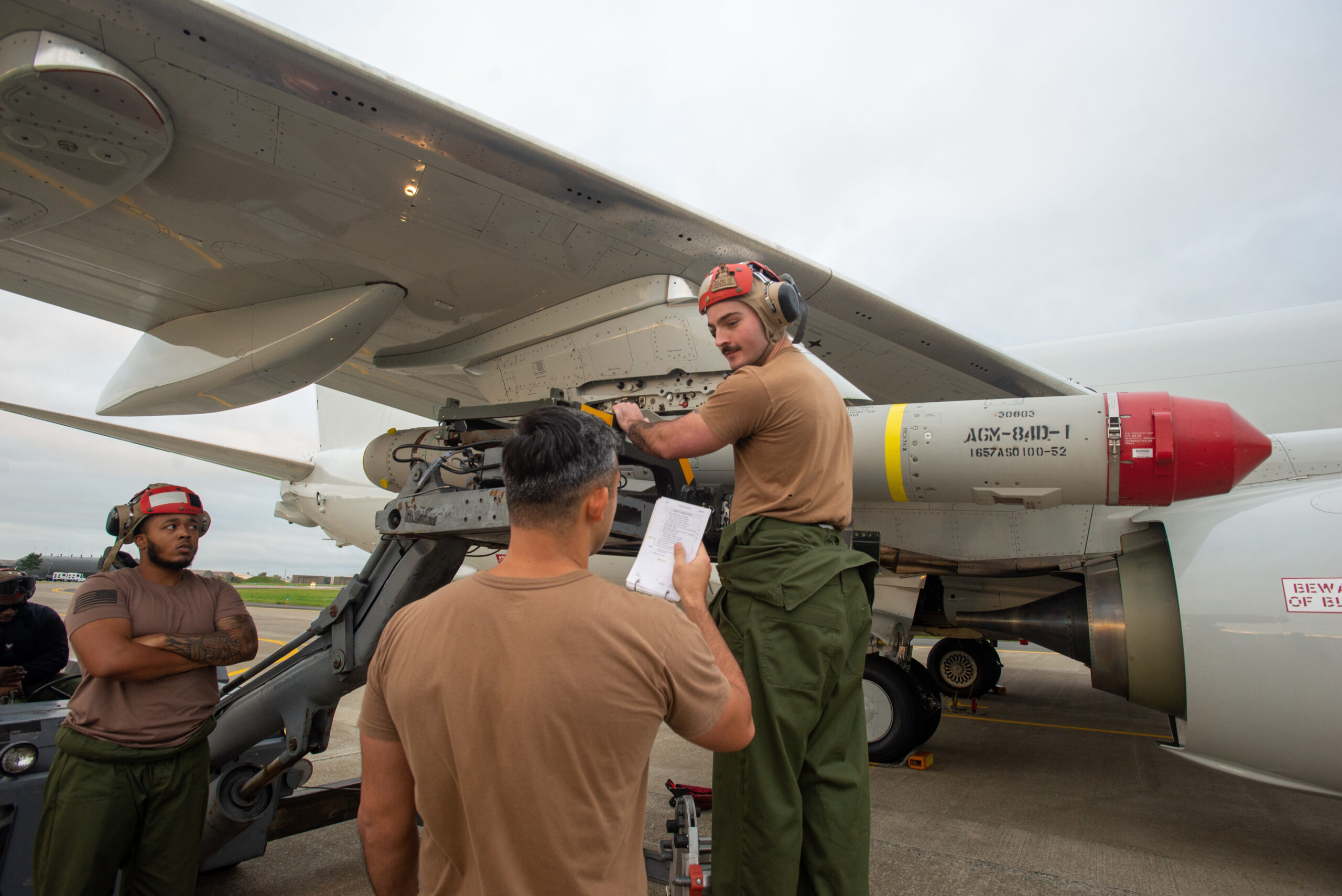
Operational Experimentation
The contribution of airborne assets to networked ASW was tested – and demonstrated – recently during NATO Allied Maritime Command’s (MARCOM’s) annual, North Atlantic-based ASW exercise, ‘Dynamic Mongoose’. The exercise, based around Standing NATO Maritime Group 1 (SNMG1), takes place in the deep North Atlantic waters between Norway and Iceland.
‘Dynamic Mongoose’ provides a ‘live exercise’ (LIVEX) forum to enable NATO allies to test various ASW capabilities; it also provides a forum for demonstrating – to various adversaries – such capabilities in a ‘real world’ operational environment and context. Certainly, the waters between Iceland and Norway will be a hive of submarine and anti-submarine activity, as NATO seeks to build maritime deterrence and defence capability of its northern flank to offset risk of the Russo-Ukraine war spilling over into the maritime domain.
The 2023 iteration of ‘Dynamic Mongoose’ took place in May, once more between Iceland and Norway – waters that MARCOM referred to (in a statement issued at the exercise’s conclusion) as a “strategic location”. MARCOM added that the exercise included “significantly higher” participation this year, along with conduct of the full spectrum of ASW procedures.
Twelve NATO members took part, with 10 of these providing a combined total of 15 surface ships and seven of them providing a combined total of eight MPAs.
The MPA presence included: two Royal Canadian Air Force Lockheed Martin CP-140 Auroras; one French Air Force Dassault Aviation Atlantique Mk 2; one German Navy P-3C Orion; two UK RAF P-8As; and two USN P-8As, a MARCOM spokesperson told ESD in a statement on 7 July. During the exercise, the MPA capability was focused on ASW with search, track, and engagement of submarines using active and passive sensing capability.
“Airborne ASW assets, particularly MPAs, can contribute significantly to a networked, deep-water ASW [capability]. They can provide long-range, persistent, multi-sensor, multi-weapon, networked, all-weather capabilities that can complement and enhance other assets over the whole ASW theatre,” the MARCOM spokesperson continued. “Moreover, MPAs equipped with multi-static sonobuoys can improve networked, deep-water ASW by providing longer detection ranges and lower false alarm rates than conventional mono-static sonars.”
NATO operators are now building experience of putting P-8A capability into operational practice in the Euro-Atlantic theatre.
User Requirements
The RNoAF’s transition from P-3C to P-8A points to the accelerating speed of P-8A capability arrival in the North Atlantic region. The first RNoAF P-8 arrived at Evenes in February 2022. All five aircraft are scheduled to be in Evenes by the end of 2023. In June 2023, the Norwegian Ministry of Defence published ‘The Military Advice of the Chief of Defence 2023’, drawn up by Chief of Defence General Eirik Kristoffersen following a November 2022 government request for recommendations on requirements for re-structuring the armed forces to meet the increasing and changing nature of defence and security threats to Norway’s interests. Norway’s last ‘Military Advice’ report was issued in 2019.
The latest advice noted that maritime patrol is one of “a core set of capabilities” that the Norwegian Armed Forces must retain, in order to maintain both joint operations capability and the capacity to inflict losses in all domains upon an adversary. Within the air domain, the Chief recommended that the RNoAF continues to prioritise, alongside fighting for air supremacy, the mission of contributing to ASW in the maritime domain.
Perhaps most notably, the Chief’s report stated that “The capability to conduct anti-submarine operations will require further investment in complementary capabilities”: here, the report noted the need for increasing investment in satellite surveillance, ground-based sensors, and MPAs. While the report did not discuss any potential increase in RNoAF P-8A platform numbers, it did state that Norway’s MPA capability is one of several core air domain capabilities that “must therefore be shielded from cuts insofar as is possible.”
All nine of the UK’s P-8A Poseidons are in service, having arrived between February 2020 and January 2022. The aircraft are based at RAF Lossiemouth, on Scotland’s northeast coast. The UK’s 2021 Defence Command Paper – the UK Ministry of Defence’s most recent iteration of its capability development plan – noted that the P-8A is primarily focused on ASW to secure the UK’s waters.
Putting this perhaps more precisely, the UK’s P-8A capability plays a critical role in securing the UK’s twin strategic deterrents: the nuclear deterrent, delivered by the four Vanguard-class nuclear-powered ballistic missile submarines; and the conventional deterrent, delivered by the two Queen Elizabeth-class aircraft carriers.
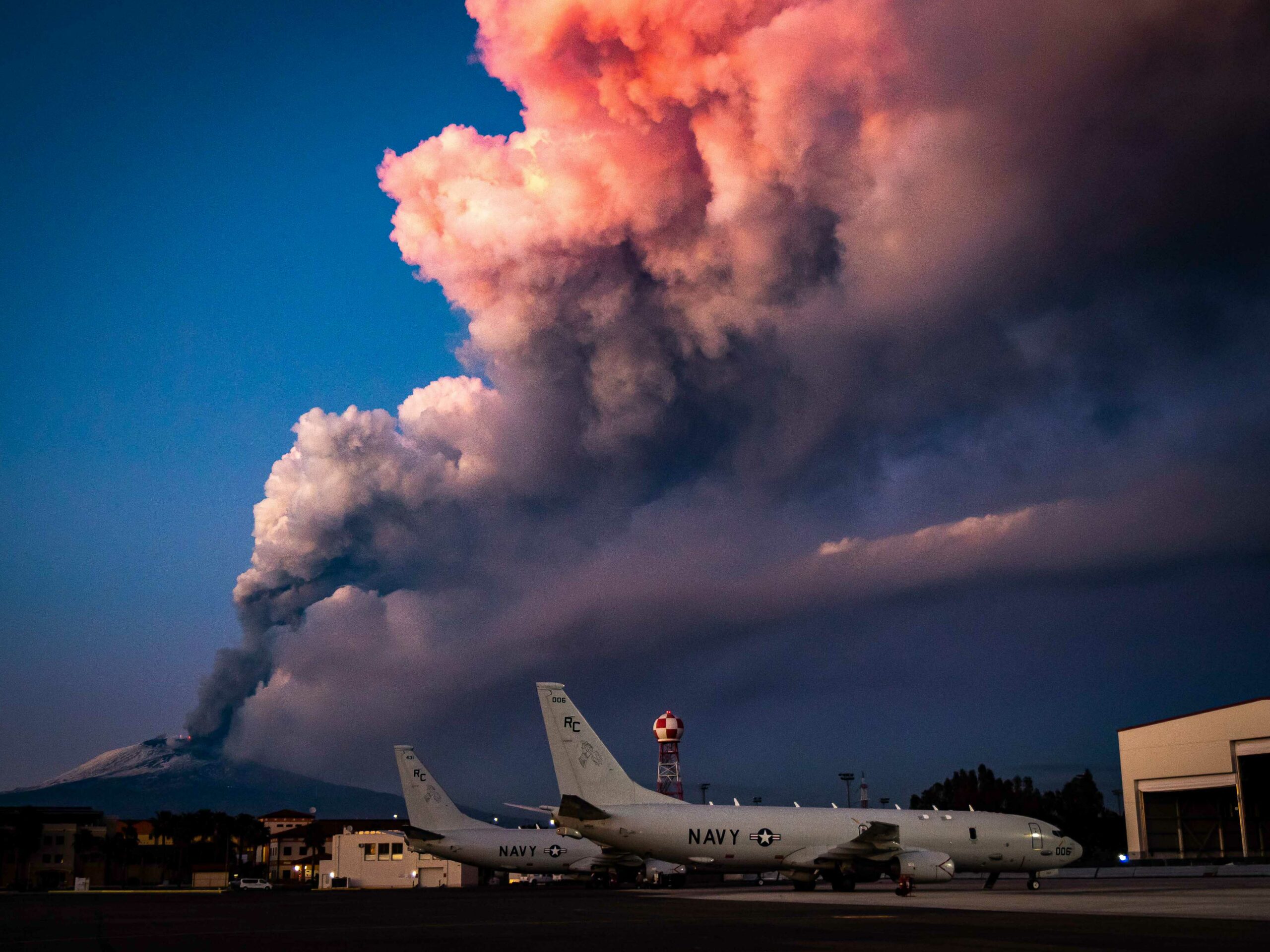
With USN P-8As forward-based at Sigonella Naval Air Station, Sicily and having been deploying widely across the Euro-Atlantic theatre for some time now, the trilateral US/UK/Norway partnership today now encompasses operational co-operation as well as basing, logistics, and training. Such co-operation, especially at the operational level, provides improved combined capability especially through the generation of mass. Such mass is critical when policing choke points like the Bear Island and GIUK gaps and prosecuting submarine targets trying to slip through the ASW nets NATO seeks to lay across these gaps.
In one of the most recent examples of such trilateral integration, in July 2023 the RAF deployed a P-8A to Evenes in Norway for bilateral exercising. According to an RAF news report, “The exercise was designed to strengthen bilateral working arrangements … [and gave] the RAF crew valuable experience of operating from an unfamiliar location over mountainous terrain.” Moreover, the report continued, the deployment included anti-surface warfare (ASuW) training and tested the capacity of the RAF P-8As to integrate effectively into Norwegian Air Operations Centre tasking.
“UK Poseidons operating in the High North are critical to maintaining the safety and security of the seas around our Joint Expeditionary Force [JEF] and NATO allies. In light of an aggressive and expansionist Russia operating within close proximity to our territorial waters, it is vital we continue to secure our seas,” Wing Commander Ben Livesey, Commanding Officer of the RAF’s 120 (CXX) P-8A Poseidon Squadron, said in the report.
Norway and the UK are two of the 10 partner members of the UK-led JEF construct, which brings particular focus on maritime matters and is designed to provide a strategic and operational bridge across the sub-conflict threshold security phase that links national defence interests and NATO requirements to conduct deterrence and defence of member state interests and territories at the higher end of the operational spectrum.
The RAF P-8A’s training development across 2023 has included other tasking in addition to ASW and ASuW exercising. For example, in May an RAF P-8A participated in the annual NATO ‘Formidable Shield’ integrated air and missile defence exercise. The UK P-8A capability has also been making its presence felt in real-world operations. In June, a P-8A worked with the RN Type 45 air-defence destroyer HMS Defender to monitor three Russian warships – including an Admiral Grigorovich class frigate and two Steregushchiy class corvettes – that were operating close to UK waters.
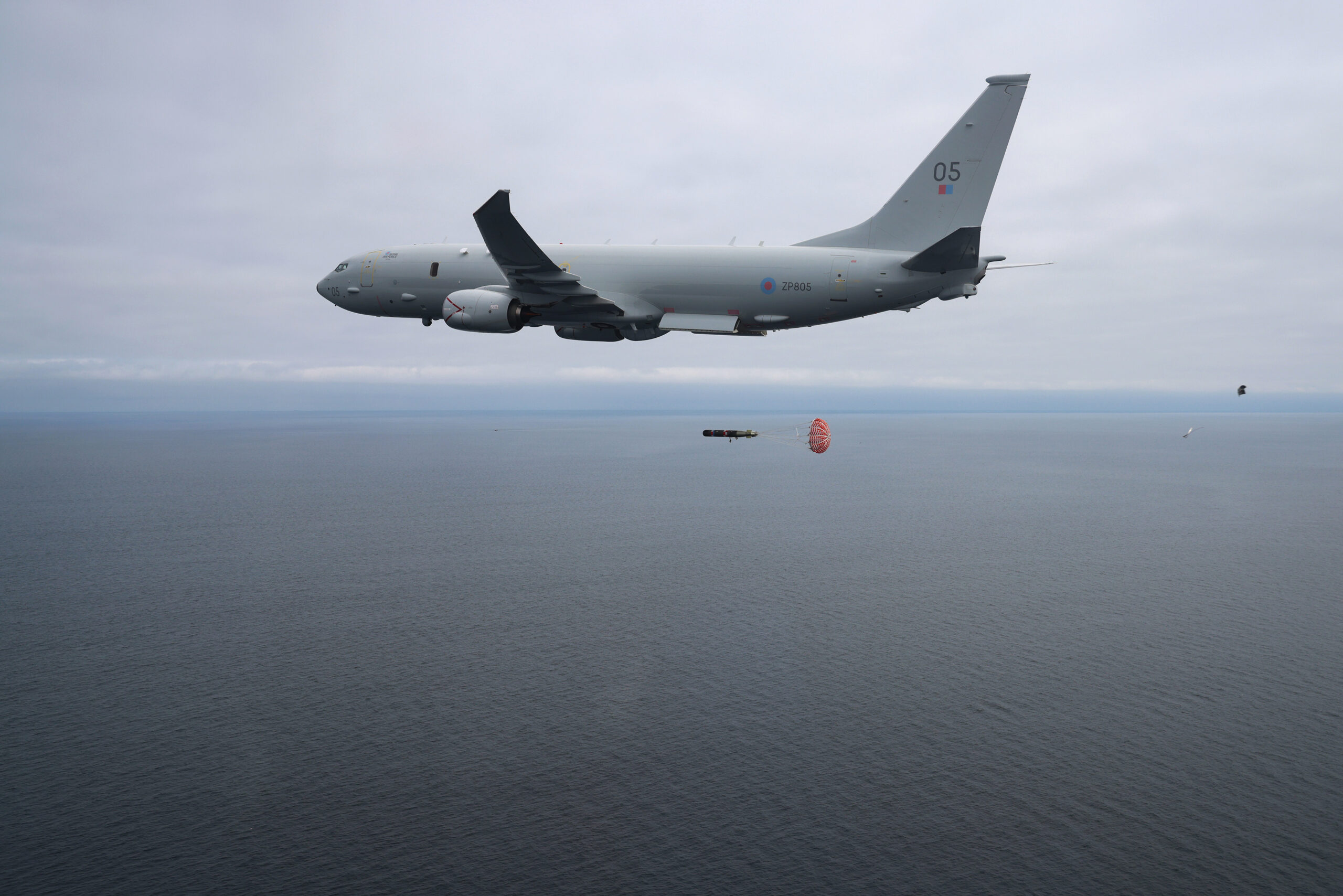
Later in June, a UK P-8A deployed to work with the USN’s USS Gerald R Ford carrier strike group (CSG). The Ford CSG is the USN’s newest CSG, and was back in European waters for its second deployment in quick succession – this time, for its first operational deployment (its first visit in late-2022 was for the NATO-led ‘Silent Wolverine’ task group integration exercise). Also part of the Ford CSG for this most recent deployment were RN and Royal Norwegian Navy (RNoN) surface ships. In a further RAF news report, the service noted that “These exercises are designed to enhance combined interoperability and develop the ability to maintain agile, capable, and expeditionary forces with the ability to flexibly operate within the High North region.”
In the report, the RAF added that integrated exercises with task forces such as the Ford CSG – as well as continuing training to support MARCOM and associated units – were further steps being taken in building the UK’s P-8A output towards full operational capability.
P-8A presence across the North Atlantic, but perhaps especially in critical areas such as the Baltic and North seas, will be enhanced in due course by the arrival of German Navy P-8As. In September 2021, Germany announced a deal for five aircraft, and all five are scheduled to be delivered by the end of February 2025.
Integrated NATO capability
The P-8A is fast becoming the predominant MPA across the NATO area of operations. In spreading its capability across the Euro-Atlantic theatre, the P-8A provides presence from strategic, to operational, to tactical levels.
Strategically, the P-8A is bringing together an integrated maritime network of operators deploying state-of-the-art MPA capability across the theatre, and in a manner that is becoming interchangeable in terms of basing locations and contributions to allies’ and partners’ task groups.
In the latter context, the P-8A is also demonstrating the significance of its operational impact, with the presence of P-8As in operational task groups underlining not only the aircraft’s role in integrated task group protection, but also how the wider presence and specific prosecution of ASW targets is once more becoming a task force – in other words, joint – activity for NATO navies.
In tactical terms, the P-8A’s ability to provide rapid response and a range of ASW capabilities quickly on target underlines the flexibility of its contribution to NATO’s tactical ASW fight.
This combination of strategic, operational, and tactical capability and effect in one airframe could be seen as perhaps the single, stand-out answer to the question of what the P-8A Poseidon provides in terms of making a unique airborne contribution to contemporary ASW operations.
Dr Lee Willett









